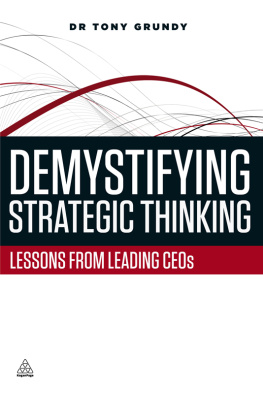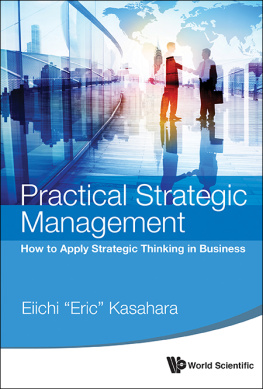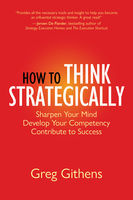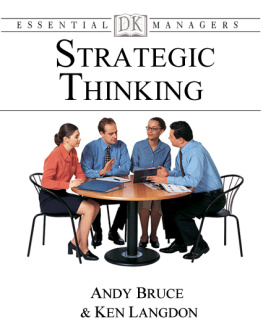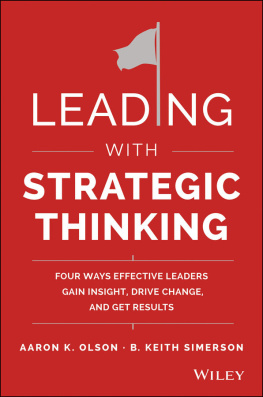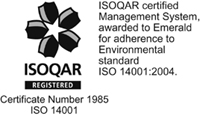STRATEGIC THINKING
A Comprehensive Guide
STRATEGIC THINKING
A Comprehensive Guide
BY
FREDERICK BETZ
Portland State University, USA

United Kingdom North America Japan
India Malaysia China
Emerald Group Publishing Limited
Howard House, Wagon Lane, Bingley BD16 1WA, UK
First edition 2016
Copyright 2016 Emerald Group Publishing Limited
Reprints and permissions service
Contact:
No part of this book may be reproduced, stored in a retrieval system, transmitted in any form or by any means electronic, mechanical, photocopying, recording or otherwise without either the prior written permission of the publisher or a licence permitting restricted copying issued in the UK by The Copyright Licensing Agency and in the USA by The Copyright Clearance Center. Any opinions expressed in the chapters are those of the authors. Whilst Emerald makes every effort to ensure the quality and accuracy of its content, Emerald makes no representation implied or otherwise, as to the chapters suitability and application and disclaims any warranties, express or implied, to their use.
British Library Cataloguing in Publication Data
A catalogue record for this book is available from the British Library
ISBN: 978-1-78560-467-6
Contents
Preface
Leadership and strategy are intricately connected, because one of the primary responsibilities of leaders is to formulate strategy; and in an organization, only the leader has the power to implement change, strategic change. Thus, strategic thinking is a necessary and fundamental cognitive ability of a leader or should be so.
Strategic thinking is about (1) imagining a future world and (2) taking a sequence of short-term tactical actions to achieve it. It requires both an idealism (to imagine a better world) and a realism (to acquire the resources, skills, and organization to get there). However, most organizations focus and encourage only short-term thinking for their employees and leave long-term strategy to the executives. And many books on strategy assume this is appropriate and do not question the practice. But there is a serious error about realism, in a view of only top-down strategy. No high-level executive in any organization, at any time, in any place, is ever fully knowledgeable about the details of operations activities on the ground, the current reality in the trenches. This is because the executive level is far above the actual operations of production/sales and so can be out-of-touch with the operational. In climbing their careers to the top of organizational power, executives probably knew the past realities quite well. It is their grasp of current reality which can be in question. This is what strategy is for to distinguish past reality from current reality and to prepare for future reality.
Thus for realistic strategy, there is a need for good top-down and bottom-up communication between the executives at the top-management level and the technical personnel at the bottom-operations level. When organizational communication is only top-down (due to the overwhelming power-of-the-boss), then in such an organization, high-level strategy can become only wishful thinking by the CEO a wishing that can actually impose harmful management pressure on operations. Harmful pressure has resulted in terrible examples of organizational ineffectiveness, loss of competitiveness, and even fraud.
Unfortunately, there are many historical examples of this. Cases of contemporary financial failure and fraud abound in the modern world all due to unreal strategy at the top. Some of these were: the Libor Fraud of 2011, the Eurodollar Crisis of 20102014, the Global Financial Collapse of 20072008, the Bankruptcy of Enron and the Demise of Arthur Anderson in 2001. In each case, high-level officials in government and business were unrealistic about strategy allowing dishonesty of trading in Barclays, funding excessive sovereign borrowing in European Union countries by EU banks, securitization of fraudulent mortgage derivative products, and the off-book speculative investments by a company. In each of these cases, there was a serious failure of strategic thinking by top business and government officials. The wishful strategic thinking by bank executives in the Libor case was that Libor was an honest index. The wishful strategic thinking by government officials in the Eurodollar Crisis was that government debt could forever finance government services without taxes. The wishful strategic thinking in the Global Financial Crisis was the financial markets are perfect (self-regulating). The wishful strategic thinking in the Bankruptcy of Enron and the failure of Anderson was that accounting need not be fully transparent. A purpose of proper strategic thinking is to eliminate wishful-thinking from strategic thinking.
Yet there are splendid examples of strategic thinking that has been extraordinarily successful, such as: IBM in its early days, Xerox in its early days; the resurrection of the Japanese economy and SONY, Honda, Toyota in Japan; the building of the South Korean economy and Samsung, Hyundai, Posco in Korea.
What is the type of thinking which leads to long-term success and survival, not just a big payoff in the short term? This is strategic thinking. Strategic thinking is necessary at every level of an organization, and not just at the top. We use actual histories of business successes or failures to illustrate theoretical concepts in strategic thinking.
These concepts are summarized in each chapter.
Theoretical Principles of Strategy
- 1.1All actions are directed toward the future; and intelligent action is most likely to succeed.
- 1.2Correct vision is necessary to survive discontinuities.
- 1.3Technology strategy is a basic component of competitive strategy.
- 1.4Strategy is cognitively more synthetic (intuition); while planning is more analytic (thinking).
- 1.5Intuition is primarily based upon experience.
- 1.6The way of experience is perception, preparation, and commitment.
- 1.7Strategic wisdom is expressed in the form of precepts.
- 2.1Strategy is implemented in a sequence of tactics leading toward the mission.
- 2.2Entrepreneurial strategy is proper for the launching of new businesses.
- 2.3Technology progress is a major source of entrepreneurial opportunity
- 3.1While entrepreneurial management is necessary to starting a new business, professional management is necessary to grow the business competitively.
- 3.2Tactical milestones are steps in achieving a long-term strategy.
- 4.1Strategic change is periodically necessary to survive and prosper.
- 4.2Strategy divides into content (strategic issues) and into process (strategic planning).
- 4.3Strategic perspective divides into top-down perspective (executive perspective) and bottom-up perspective (operational perspective).
- 4.4The strategy process requires formulation of the big picture as a strategic scenario and the operations picture as a strategic business model.
- 5.1The four factors of product success are: performance, innovation, market focus, competitive pricing.
- 5.2Six kinds of strategic business models can be constructed from the combination of the factors of capital, profit, sales, resources.
Next page




